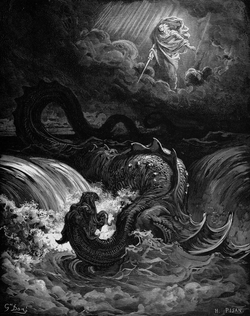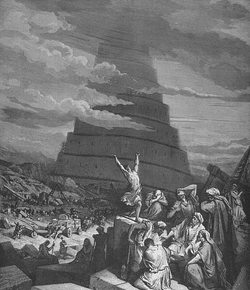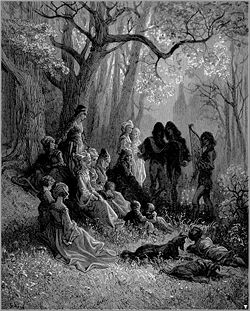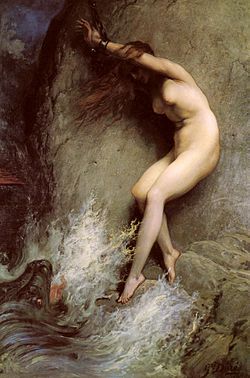Top Qs
Timeline
Chat
Perspective
Gustave Doré
French illustrator and painter (1832–1883) From Wikipedia, the free encyclopedia
Remove ads
Paul Gustave Louis Christophe Doré (UK: /ˈdɔːreɪ/ DOR-ay, US: /dɔːˈreɪ/ dor-AY; French: [ɡystav dɔʁe]; 6 January 1832 – 23 January 1883) was a French printmaker, illustrator, painter, comics artist, caricaturist, and sculptor. He is best known for his prolific output of wood-engravings illustrating classic literature, especially those for the Vulgate Bible and Dante's Divine Comedy. These achieved great international success, and he became renowned for printmaking, although his role was normally as the designer only; at the height of his career some 40 block-cutters were employed to cut his drawings onto the wooden printing blocks, usually also signing the image.[1]
He created over 10,000 illustrations, the most important of which were copied using an electrotype process using cylinder presses, allowing very large print runs to be published simultaneously in many countries.[2]
Although Doré's work was popular with the general public during his life, it was met with mixed reviews from contemporary art critics. His work has been more widely celebrated in the centuries following his death. Among his admirers were writers H. P. Lovecraft and Théophile Gautier.
Remove ads
Biography
Summarize
Perspective

Doré was born in Strasbourg on 6 January 1832. At the age of 15, he began his career working as a caricaturist for the French paper Le journal pour rire.[3] The illustrations of J. J. Grandville have been noted as an influence on his work.[4] Wood-engraving was his primary method at this time.[5] In the late 1840s and early 1850s, he made several text comics, like Les Travaux d'Hercule (1847), Trois artistes incompris et mécontents (1851), Les Dés-agréments d'un voyage d'agrément (1851) and L'Histoire de la Sainte Russie (1854). Doré subsequently went on to win commissions to depict scenes from books by Cervantes, Rabelais, Balzac, Milton, and Dante.
In 1853 Doré was asked to illustrate the works of Lord Byron.[6] This commission was followed by additional work for British publishers, including a new illustrated Bible. In 1854 he illustrated Gargantua et Pantagruel. In 1856 he produced 12 folio-size illustrations of The Legend of The Wandering Jew, which propagated longstanding antisemitic views of the time,[7] for a short poem which Pierre-Jean de Béranger had derived from a novel of Eugène Sue of 1845.[8][9][10]

In the 1860s he illustrated a French edition of Cervantes's Don Quixote, and his depictions of the knight and his squire, Sancho Panza, became so famous that they influenced subsequent readers, artists, and stage and film directors' ideas of the physical "look" of the two characters.[11] Doré also illustrated an oversized edition of Edgar Allan Poe's "The Raven", an endeavor that earned him 30,000 francs from publisher Harper & Brothers in 1883.[12]
The government of France made him a Knight of the Legion of Honour in 1861.[13]

Doré's illustrations for the Bible (1866) were a great success, and in 1867 he had a major exhibition of his work in London. This exhibition led to the foundation of the Doré Gallery in Bond Street, London.[14] In 1869, Blanchard Jerrold, the son of Douglas William Jerrold, suggested that they work together to produce a comprehensive portrait of London. Jerrold had obtained the idea from The Microcosm of London produced by Rudolph Ackermann, William Pyne, and Thomas Rowlandson (published in three volumes from 1808 to 1810).[15] Doré signed a five-year contract with the publishers Grant & Co that involved his staying in London for three months a year, and he received the vast sum of £10,000 a year for the project. Doré was celebrated for his paintings in his day, but his wood-engravings, like those he did for Jerrold, are where he excelled as an artist with an individual vision.[citation needed]
The completed book London: A Pilgrimage, with 180 wood engravings, was published in 1872. It enjoyed commercial and popular success, but the work was disliked by some contemporary British critics, as it appeared to focus on the poverty that existed in parts of London. Doré was accused by The Art Journal of "inventing rather than copying."[16] The Westminster Review claimed that "Doré gives us sketches in which the commonest, the vulgarest external features are set down."[17] But they impressed Vincent van Gogh, who painted a version of the Prisoners' Round in 1890, the year of his death. The book was a financial success, however, and Doré received commissions from other British publishers.[citation needed]
Doré's later work included illustrations for new editions of Coleridge's Rime of the Ancient Mariner, Milton's Paradise Lost, Tennyson's Idylls of the King, The Works of Thomas Hood, and The Divine Comedy. Doré's work also appeared in the weekly newspaper The Illustrated London News.[citation needed]
The medical doctor Jean-Baptiste Fuzier, who was a specialist in yellow fever and other tropical diseases, bequeathed watercolor paintings by Doré to the museum of Grenoble in 1880. According to the Musée de Grenoble, Doré developed his expertise as a watercolorist during a trip to Scotland in 1873.[18]
Remove ads
Death
Doré never married and, following the death of his father in 1849, he continued to live with his mother, illustrating books until his death of a heart attack in Paris on January 23, 1883, following a short illness.[19] At the time of his death Doré was working on illustrations for an edition of Shakespeare's plays.[20]
Works
Summarize
Perspective
Doré was a prolific artist; thus the following list of works is not complete and it does not include his paintings, sculptures, and many of his journal illustrations:
Remove ads
Reception and legacy
Doré's work received mixed reviews from contemporary art critics, but he was widely acclaimed by the general public. He was adored by many writers and poets, who felt he "brought their wildest dreams and fantasies to life".[39] Théophile Gautier for example stated "Nobody better than this artist can give a mysterious and deep vitality to chimeras, dreams, nightmares, intangible shapes bathed in light and shade, weirdly caricatured silhouettes and all the monsters of fantasy."[39] H.P. Lovecraft drew inspiration from Doré's Rime of the Ancient Mariner illustrations in his formative years.[40]
Remove ads
Gallery
- Illustrations
- Destruction of Leviathan, 1865
- The Vision of The Valley of The Dry Bones, 1866
- The Deluge, 1866
- Engraving The Tower of Babel or the Confusion of Tongues, 1866
- Edyrn with His Lady and Dwarf Journey to Arthur's Court, in Idylls of the King by Lord Alfred Tennyson, illustrated by Gustave Doré
- Doré illustrated several fairy tales: Cendrillon (or Cinderella)
- La Belle au Bois Dormant - third of six engravings by Gustave Doré
- Drawing, A Backstreet in London (1868; National Gallery of Art, Washington)
- Over London by Rail Gustave Doré c 1870. From London: A Pilgrimage
- Ludgate Hill - A block in the Street, 1872. From London: A Pilgrimage
- Crusades troubadours singing the glories of the crusades
- Don Quixote illustrated by Gustave Doré
- Don Quixote illustrated by Gustave Doré, another one of the 500 pieces Doré created for the work
- Miguel de Cervantes's Don Quixote illustrated by Gustave Doré
- Another example of Don Quixote (Don Quijote in Spanish) illustrated by Gustave Doré
- Rabelais's Gargantua (English translation)
- St. John's vision - Sagrada Biblia T4
- Ark of the Covenant - La Sagrada Biblia T4
- Roland, count of Mans, knight of Blaives - Days of Chivalry (Croquemitaine)
- Roland the Peerless - Days of Chivalry (Croquemitaine)
- The Houris on Camels - Days of Chivalry (Croquemitaine)
- Sculptures
- The Dumas Monument in Paris
- Le Poème de la Vigne or The Vintage Vase, version in San Francisco
- Cupid and Time, modello in terracotta
- A clock with Time defeating Loves, cast 1879
- Maenads in a Wood, 1879, plaster modello, Museum of Fine Arts, Boston
- Paintings
- Roland à Roncevaux, private collection, Paris
- La Sainte Trinité, Glynn Vivian Art Gallery
- Ecce Homo, Glynn Vivian Art Gallery
- La folie, Glynn Vivian Art Gallery
- Paolo and Francesca da Rimini, 1863
- Christ Leaving the Praetorium in the room of the Strasbourg Museum of Modern and Contemporary Art where it hangs
- Andromède, 1869, Chimei Museum, Tainan, Taiwan
- Soir en Alsace, 1869
- La Siesta, Memory of Spain, c. 1868
- Flower Sellers of London, c. 1875
- Loch Lomond, 1875
- Landscape in Scotland, ca. 1875, Toledo Museum of Art
- Landscape in Scotland, ca. 1878, Walters Art Museum
- Mont Sainte-Odile avec mur païen, by 1883
- The Valley of Tears, 1883
- The Triumph Of Christianity Over Paganism (1868)
Remove ads
References
Further reading
External links
Wikiwand - on
Seamless Wikipedia browsing. On steroids.
Remove ads

















































